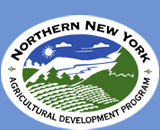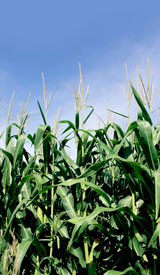February 11, 2008
Contact: Joe Lawrence, 315-376-5270, or your local Cornell Cooperative
Extension office
Note: Meetings are set for West Chazy, Malone, Canton, Lowville &
Watertown
Nitrogen: How much do you need, how much can you save?
Find out at March Fertilizer Meetings in NNY
Corn is grown on more than 120,000 acres across Northern New York. But
just how much fertilization does corn need to grow well? Is it true that
for some fields using less nitrogen (N) can save farmers money and still
produce a good crop? How does a farmer tell which fields need extra N
and which do not?
The answers to these questions and others may save farmers money, time
and labor. Dr. Quirine M. Ketterings of Cornell University, Everett
Thomas of the William H. Miner Agricultural Research Institute, and
Cornell Cooperative Extension educators from NNY will provide the latest
nutrient management research results at Making the Most of Your
Fertilizer Dollar meetings scheduled across Northern New York for the
week of March 17-21.
With funding from the Northern New York Agricultural Development Program
and the New York Farm Viability Institute, Ketterings, her Cornell
research team and Cornell Cooperative Extension field crop educators in
NNY have conducted several projects that are successfully quantifying
and predicting the nitrogen (N) needs for growing corn, and, in turn,
saving farmers money and reducing environmental impact.
�We are determining under what situations extra nitrogen would be good
to add to a field and when a farmer can save money by reducing
fertilizer applications without impacting yield and quality,� says
Ketterings, an associate professor of crop and soil sciences. �This is
the best way to minimize the potential negative environmental and
economic impacts of excess N fertilizer use.�
Joe Lawrence, a former graduate student of Ketterings in the Nutrient
Management Spear Program at Cornell, is now field crops educator with
Cornell Cooperative Extension of Lewis County. Lawrence says, �Now more
than ever we need to focus on efficient use of nutrients on the farm.
For example, we need to recognize that sod crops are an excellent source
of nitrogen for the subsequent corn crop and that our soils have a great
ability to supply nitrogen for growing.�
As a student, Lawrence worked on a project evaluating the use of
additional nitrogen on first-year corn grown after sod. He says, �None
of the 16 first-year corn trials responded to additional nitrogen after
the starter fertilizer. The forage grass and/or legume gave enough
nitrogen back to the soil to feed the following year�s corn crop and
forage quality was not negatively impacted.�
After participating in the on-farm N evaluation trial in 2005, farmer
Mike
Kiechle of Garden of Eden Farm in Philadelphia, N.Y. cut his use of
nitrogen on first-year corn. He says, �This on-farm research trial
showed I was wasting money. I cut back my nitrogen applications and that
has saved me about $10-$12 per acre.�
How to use soil nitrogen tests to help identify N levels in farm fields
is on the
agenda for the March meetings. Other topics include soil pH management,
tillage options for conserving manure nitrogen in soils, understanding
fertilizer choices, how to use test strips to try different crop
treatments, how to determine starter and broadcast fertilizer needs,
when nitrogen should be applied in a crop rotation.
Making the Most of Your Fertilizer Dollar meetings will be held March 17
in West Chazy, March 18 in Malone, March 19 in Canton, March 20 in
Lowville, and March 21 in Watertown. Contact your local Cornell
Cooperative Extension for details. CCA credits may be possible.
To learn more about nutrient management research conducted in Northern
New York and for fact sheets, visit the website at www.nnyagdev.org. The
farmer-driven Northern New York Agricultural Development Program
prioritizes and funds research and outreach that provides practical
knowledge and tools to improve the productivity and profitability of
farms in Clinton, Essex, Franklin, Jefferson, Lewis and St. Lawrence
counties. # # #



